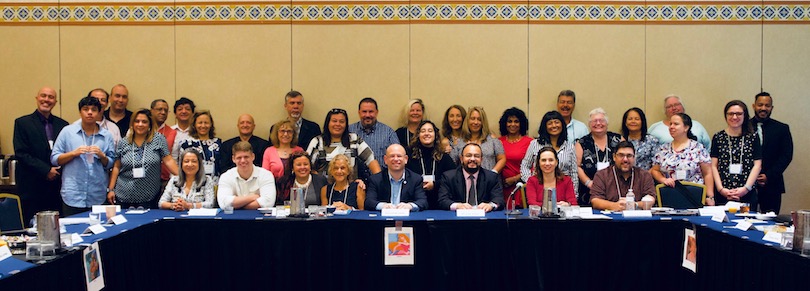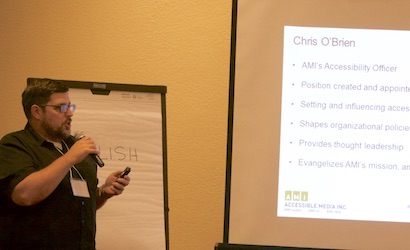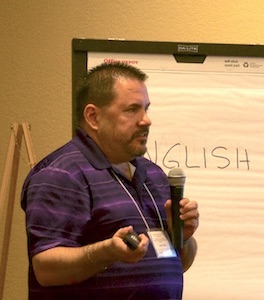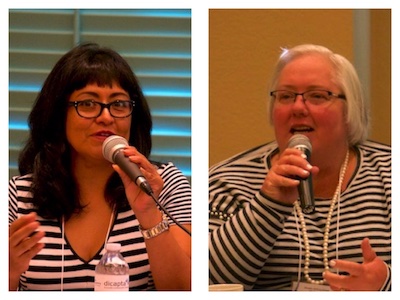Fantastic Meeting with our Advisory Group

Last August we had the annual meeting of our project's Advisory Group. As usual, it was delightful to see the members of our Advisory Group again and embrace the representatives of other organizations that work with our community. Jo Ann McCann, from the U.S. Department of Education, participated virtually in part of the meeting.

Besides presenting the results of our work, the meeting was an important opportunity to look to the future and reflect on the type of legacy we want to leave once the project ends. The conversation with everybody was so productive that one of the immediate results was the offer, from Canal 22 Internacional, to give the Described and Captioned Media Program (DCMP) the authorization to use the accessible content that the channel has.
The Cable-Friends that were part of our meeting were Canal 22 Internacional y SupereÑe, to whom we are providing accessibility features for some of their programming thanks to our project.
 Orissa Castellanos, from Canal 22 Internacional, gave a brief presentation about the channel's mission and programming. Canal 22 Internacional is the international signal of the Mexican cultural channel Canal 22. Its mission is to disseminate the best artistic and cultural expressions from Mexico and the world. It has an audience of about 1.75 million. Thanks to its commitment to accessibility, the channel created an accessible programing slot on the weekends from 6:30 to 7:30 p.m. (ET)/ 3:30 to 4:30 p.m. (PT). Their goal is to create awareness about the availability of this service. Antoni and Carla D'Ocon presented the channel SupereÑe, which is identified by a superhero with a mask and a white suit. He teaches spelling and grammar rules to the viewers. The channel shows a variety of animated TV series and its objective is to bring a positive and optimistic message. The channel's programs are announced by one of three characters: SupereÑe, 6UR4 and Marta. Currently, the channel presents content with open accessibility, in other words, the captions and descriptions can be seen and heard by everybody.
Orissa Castellanos, from Canal 22 Internacional, gave a brief presentation about the channel's mission and programming. Canal 22 Internacional is the international signal of the Mexican cultural channel Canal 22. Its mission is to disseminate the best artistic and cultural expressions from Mexico and the world. It has an audience of about 1.75 million. Thanks to its commitment to accessibility, the channel created an accessible programing slot on the weekends from 6:30 to 7:30 p.m. (ET)/ 3:30 to 4:30 p.m. (PT). Their goal is to create awareness about the availability of this service. Antoni and Carla D'Ocon presented the channel SupereÑe, which is identified by a superhero with a mask and a white suit. He teaches spelling and grammar rules to the viewers. The channel shows a variety of animated TV series and its objective is to bring a positive and optimistic message. The channel's programs are announced by one of three characters: SupereÑe, 6UR4 and Marta. Currently, the channel presents content with open accessibility, in other words, the captions and descriptions can be seen and heard by everybody.
 Chris O'Brien from Accessible Media Inc. (AMI), Canadá, told us about the wonderful work that his organization has done. It created AMI-tv: the only digital channel in the world that offers all its programming with open video description and captions. AMI's work started in 1989 as the National Broadcast Reading Service to give people with limited vision equal access to the news published by newspapers. Nowadays, AMI offers 3 channels AMI-audio, AMI-tv and AMI-télé (this last one to serve the French speaking population in Canada). In addition, AMI created its own description methodology: Integrated Described Video (IDV) with the objective of offering descriptions that are natural part of the dialogs and narrations of a program. IDV is inspired by the Universal Design practices.
Chris O'Brien from Accessible Media Inc. (AMI), Canadá, told us about the wonderful work that his organization has done. It created AMI-tv: the only digital channel in the world that offers all its programming with open video description and captions. AMI's work started in 1989 as the National Broadcast Reading Service to give people with limited vision equal access to the news published by newspapers. Nowadays, AMI offers 3 channels AMI-audio, AMI-tv and AMI-télé (this last one to serve the French speaking population in Canada). In addition, AMI created its own description methodology: Integrated Described Video (IDV) with the objective of offering descriptions that are natural part of the dialogs and narrations of a program. IDV is inspired by the Universal Design practices.
 Jason Stark, from the DCMP, presented the DCMP Accessible Television Portal. It offers a broad collection of educational contents with captions and video description that can be watched online by registered users. It has more than 561 accessible TV episodes from well know companies. The DCMP also develops tools to ease the creation and delivery of accessible content.
Jason Stark, from the DCMP, presented the DCMP Accessible Television Portal. It offers a broad collection of educational contents with captions and video description that can be watched online by registered users. It has more than 561 accessible TV episodes from well know companies. The DCMP also develops tools to ease the creation and delivery of accessible content.
Maria Victoria Diaz and Olga Collazos, from Dicapta, talked about the barriers to the availability of accessible content in the US TV. The limited accessibility is due, among other reasons, to the fact that most of the Spanish channels are exempt from complying with the captioning and video description legislation, and the industry's lack of interest of delivering accessibility services to its audience.
 Teresa Peña, a leader of families of children with disabilities in North Carolina, told us about the superb job she does through the Parents Training and Information Center (PTI) of the Exceptional Children's Assistance Center (ECAC). She helps parents become collaborative leaders, who work with other families to create an environment where families support each other. The PTI's work has impacted more than 400 families. Margaret Barrera, from the Texas Education Agency (TEA), spoke about the Students with Sensory Impairment Network in Texas, that provides a variety of services to the students and works with families, local agencies and communities. TEA works in collaboration with 20 Education Service Centers, the Texas School for the Blind and Visually Impaired, and the Texas School for the Deaf. The population of special education students in Texas is 478,009, and 243,000 of them are Hispanics.
Teresa Peña, a leader of families of children with disabilities in North Carolina, told us about the superb job she does through the Parents Training and Information Center (PTI) of the Exceptional Children's Assistance Center (ECAC). She helps parents become collaborative leaders, who work with other families to create an environment where families support each other. The PTI's work has impacted more than 400 families. Margaret Barrera, from the Texas Education Agency (TEA), spoke about the Students with Sensory Impairment Network in Texas, that provides a variety of services to the students and works with families, local agencies and communities. TEA works in collaboration with 20 Education Service Centers, the Texas School for the Blind and Visually Impaired, and the Texas School for the Deaf. The population of special education students in Texas is 478,009, and 243,000 of them are Hispanics.
 Judy Matthews and Dean Lermen, our eyes in the world of blindness allowed us to enter briefly in it. Judy taught us a respectful way to be a guide for a blind person. Instead of taking the person by the arm to guide them, we should allow them to hold our arm. In that way the other person has the control and can stop or release the arm whenever they want. Dean did a face exploring exercise that is usually done with blind babies. We worked in pairs, one person was the guide and stood behind the other person. The guide took the hands of the other person and together touched different parts of the face of the person in front. This definitely was an experience of sensory discovery.
Judy Matthews and Dean Lermen, our eyes in the world of blindness allowed us to enter briefly in it. Judy taught us a respectful way to be a guide for a blind person. Instead of taking the person by the arm to guide them, we should allow them to hold our arm. In that way the other person has the control and can stop or release the arm whenever they want. Dean did a face exploring exercise that is usually done with blind babies. We worked in pairs, one person was the guide and stood behind the other person. The guide took the hands of the other person and together touched different parts of the face of the person in front. This definitely was an experience of sensory discovery.
Dr. Juanita Rodriguez showed us the results of our project's research component. Its focus is on the positive effect of the use of accessible audiovisual content in the classroom to improve vocabulary acquisition and develop reading skills in students with sensory disabilities. Dr. Rodriguez has published 2 papers showing the results of the project.
 We couldn't miss a description workshop. The attendees worked in teams to describe a short clip and later presented their work to the whole group. That was a good exercise and a good reminder of the challenges inherent to video description.
We couldn't miss a description workshop. The attendees worked in teams to describe a short clip and later presented their work to the whole group. That was a good exercise and a good reminder of the challenges inherent to video description.
As usual, this was a fabulous opportunity to generate ideas and new ways of collaboration to serve our community. We are very grateful to our advisors and friends for their participation in our meeting, and for their unconditional support to our efforts of serving the members of the Hispanic community with sensory disabilities and their families.

